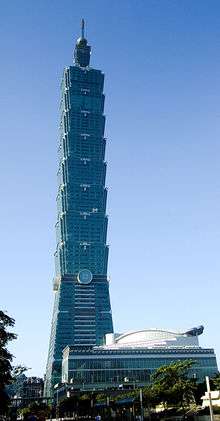Maritime industries of Taiwan
The maritime industries of Taiwan are a large part of Taiwan’s economy. Industries of particular importance are shipbuilding, boat building, maritime transport, aquaculture, mariculture, commercial fishing, seafood processing, offshore wind power and various forms of tourism. Deep sea mining, especially of dormant hydrothermal vents, is also being considered for the future.[1] In 2018 Taiwan was the fourth largest yacht building nation. Taiwan is home to a number of maritime museums and maritime colleges.

Background
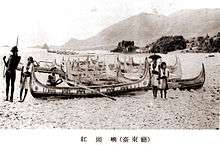
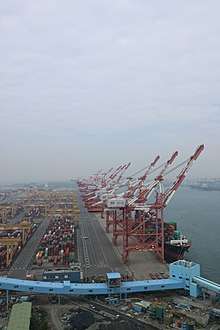
Taiwan is an island nation and as such as an intimate relationship with the sea.[2] The indigenous Yami People of Orchid Island are famous for their seafaring skills and most Taiwanese indigenous people practiced some right or ritual related to the sea. Waves of immigrants and conquerers have traveled to Taiwan over the seas from Mainland China, Europe, Japan, and elsewhere. The people of Taiwan are collectively known as the "Children of the Sea.”[3]
The principle goddess of chinese folk religion as practiced in Taiwan is the sea goddess Mazu. Her veneration is particularly popular along Taiwan’s east coast.[3]
Geographically Taiwan’s relationship with the sea is shaped by its location at the eastern end of the Eurasian landmass. The west coast is under the influence of the strong Kuroshio Current. The west coast of Taiwan is muddy with large tidal flats, tides in the west are much stronger than those on the east and as such they have a much greater influence on daily routines.[3]
The Ship and Ocean Industries R&D Center (SOIC), founded in 1976 as the United Ship Design and Development Center (USDDC), plays an important role in supporting Taiwan’s maritime industries.[4] SOIC works on commercial, government, and military projects as well as basic scientific research.[2] The Yacht Industry Department of SOIC is the only government supported R&D center for yacht materials and design in the world.[5]
Sea transport
As of 2009 90% of Taiwan’s trade was seaborne. Evergreen Marine and Yang Ming Marine Transport Corporation are two major ocean shipping companies based in Taiwan. Wan Hai Lines and Today Makes Tomorrow are smaller but still globally significant ocean shipping companies.[2] In 2016 amid a global downturn in the shipping industry the Taiwanese government spent $1.9B to support the domestic shipping industry.[6]
As of 2019 Taiwan had the 11th largest national shipping capacity by deadweight tons.[7]
Ports
Taiwan’s main ports are located in Taipei, Keelung, and Kaohsiung.[2] Most of the nation’s large ports are managed by Taiwan International Ports Corporation which is a state-owned enterprise.[7]
Shipbuilding
The modern shipbuilding industry of Taiwan began in 1948 when the Government established the Taiwan Shipbuilding Corporation (TSBC) in Keelung. In 1957 the US based Ingalls Shipbuilding Corporation established the Ingalls Taiwan Shipbuilding and Drydock Company, which subsequently rented the TSBC shipyard and produced 14 vessels between 1957 and 1962. The Government prioritized shipbuilding as one of the core industries of the economy, in 1973 they established the China Shipbuilding Corporation which was merged with TSBC in 1978. In 2008 the ship and boat building industry had a production value of 2.09b USD with CSBC accounting for 54% of production, small and medium yards 22% and yacht builders 16%.[2]
As of 2009 there were 116 shipyards (including 34 yacht builders) and 10 marine equipment companies in Taiwan. Major shipyards include CSBC Corporation, Taiwan, Jong Shyn Shipbuilding Company, and Lungteh Shipbuilding.[2] Military and Coast Guard orders make up a large portion of shipbuilders books by dollar value. Between the Taiwanese Navy and the Coast Guard Administration Taiwan spends approximately a billion dollars a year on new vessel construction.[8]
Yacht building
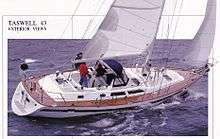
One third of new yachts sold in the US between 1977 and 1981 were made in Taiwan. In 1987 Taiwan exported 1,755 vessels worth US$190.8 million to the US. During this era more than 100 shipyards and boatbuilders in Taiwan built craft for the export market. Between 1986 and 1992 the New Taiwan Dollar appreciated 58% against the US Dollar which made Taiwanese built yachts significantly less competitive in the US market. By 1994 dozens of yacht and boat builders had gone out of business or been acquired by competitors. Sales recovered but fell again after the 2008 Recession before strengthening again.[9]
In 2017 Taiwan exported one hundred and sixty two yachts.[10] In 2018 Taiwan was the fourth largest yacht building nation by feet of yacht built after Italy, The Netherlands and Turkey. Major yacht and boat builders include Horizon Yachts, Ocean Alexander, Johnson Yachts, Jade Yachts, and Ta Shing Yacht Building.[11]
Maritime recreation
Regulations enacted during the martial law era meant that ownership of personal leisure craft was not permitted until 2010.[9] While maritime recreation facilities and infrastructure remain underdeveloped the Taiwanese government has emphasized marine sports and related tourism as an economic opportunity for Taiwan’s outlying islands.[12]
Aquaculture
.jpg)
Aquaculture has a long history in Taiwan.[13] By 2006 the production of Taiwanese coastal aquaculture was valued at NT$11,817 million.[14]
In the 21st century high technology is playing a greater part in Taiwan’s aquaculture industry as the industry struggles to cope with labor shortages and fierce foreign competition. The Taiwanese government operates six fisheries and aquaculture research centers.[15]
The Aquaculture Taiwan Expo & Forum is the primary aquaculture trade show in Taiwan, it is held concurrently with the Livestock Taiwan Expo & Forum and the Asia Agri-Tech Expo & Forum.[16]
Shrimp and prawns
The Taiwanese scientist Liao I-chiu is known as the "Father of Shrimp Farming,” having pioneered many of the techniques and overcome many of the technical hurdles which allowed the creation of the modern global shrimp farming industry.[17]
In 2020 Taiwanese shrimp researcher Luo Chu-fang received the annual award for outstanding contributions to the control of animal disease and/or veterinary public health from the World Organization for Animal Health (OIE). Luo Chu-fang is a retired academic chair at National Cheng Kung University.[18] She was the first Taiwanese to win an World Organization for Animal Health award.[19]
The giant river prawn is widely cultivated in Taiwan. In 2012 Taiwan produced 3% of world production.[20]
Grouper
In 1975 Taiwan began ocean ranching of grouper. Ocean ranching of grouper involves growing wild caught individuals to market size.[21]
In 1995 Long Diann Bio Technology Co. Ltd. with the help of the Eastern Marine Biology Research Center successfully developed hatchery techniques for giant grouper (Epinephelus lanceolatus). Other species cultured are the Malabar grouper, the orange-spotted grouper, the brown-marbled grouper, the potato grouper, and the leopard coral grouper. In the 2000s Taiwan emerged as a global leader in grouper farming. In 2007 the 89 grouper farmers on Taiwan utilized 1,554.31 hectares of land and produced 17,234 tons of grouper valued at NT$3.88 billion (US$117.68 million). Grouper are shipped live on specially built vessels to Hong Kong and mainland China.[22]
Milkfish
Milkfish is one of Taiwan’s most commercially important fish, yearly production is 50,000 tons of milkfish valued at $4.1 billion New Taiwan Dollars. Consumption and ranching of milkfish in Taiwan dates back hundreds of years.[23] Milkfish is primarily consumed with congee, pan-fried, as fish ball soup, or braised.[24] Milkfish soup (Shimu Yu) is a southern Taiwanese speciality.[25] In recent years Taiwanese farms have begun raising organic milkfish.[26]
Ornamentals
The Taiwanese ornamental fish and shrimp industry is significant with more than 250 commercial operations, ~200 of them with operations in Pingtung County. Taiwan was once known as the “cichlid kingdom” for its specialization in cichlids, a fad which culminated in the breeding of the blood parrot cichlid in 1986.[27] The fields of biotechnology and applied ecology are playing an ever increasing role in the Taiwanese aquarium sector.[28]
National Pingtung University of Science and Technology offers one of the world’s only graduate programs focussing on aquarium fish.[29]
Fisheries
Taiwan is one of the largest fishing nations on earth and the associated fish processing industry is also significant.[30] More than one third of the worlds longline tuna fishing vessels are operated by Taiwanese companies with the total strength of the distant waters fishing fleet at more than 2,000 vessels. The fishing industry is estimated to be worth approximately two billion dollars.[31] Taiwan’s ocean fisheries sector employs 350,000 people and there are 130,000 fishing households in Taiwan.[15]
Taiwanese conglomerate FCF Co, Ltd. is the largest tuna trader in the world moving more than 500,000 tons a year,[32] in 2019 they acquired Bumble Bee Foods for close to 1 billion dollars.[33]
Taiwan’s overseas fishing fleet has been criticized for a history of abuse and a lack of protection for migrant laborers, often from Southeast Asia. Official Taiwanese sources put the number of foreign workers aboard Taiwanese vessels at 26,000 but NGOs and US government agencies put the figure around 160,000. Foreign fishermen frequently report non-payment, long work hours, and verbal and physical abuse at the hands of their captains and officers, who are often Taiwanese.[31] In recent years Taiwan has made significant progress on the issue, but abuse remains widespread. In terms of human rights the distant waters fishing fleet lags far behind the rest of Taiwanese industry.[34]
A 2020 Greenpeace investigation found Taiwanese vessels in the Atlantic Ocean engaged in illegal, unreported and unregulated fishing. They also found significant evidence of the abuse of foreign laborers. They also documented Taiwanese fishing companies using flags of convenience to obscure vessel ownership as well as unreported at sea transfers of fish.[32] Taiwanese fisheries conglomerate FCF was specifically singled out for criticism for links to illegal fishing and forced labor.[35]
Offshore wind power
The first offshore wind farms in Taiwan, Formosa 1 Offshore Wind Farm, started its commercial operation in April 2017 at off the coast of Miaoli County. The Formosa II wind farms will be constructed also offshore Miaoli County with a planned capacity of 300-500 MW. The Formosa III wind farm will be constructed offshore Changhua County with a planned capacity of 1,900 MW.[36] Taiwan has one of the fastest growing offshore wind power industries in the world.[37] As of 2020, there were 361 onshore turbines and 22 offshore turbines in operation with the total installed capacity of 845.2 MW.[38]
Maritime museums
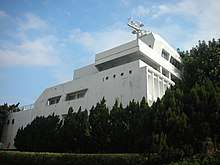
Maritime education
In 2007 the Ministry of Education released the Marine Education Policy, the first education policy document with a maritime focus.[40] As of 2014 marine and maritime education at the primary and secondary level had been greatly expanded with each of Taiwan’s 22 counties, special municipalities and cities establishing a marine education center at either an elementary or high school. Within nationwide science curriculums the portion of marine centered content has been increased. Marine issues are also taught to 9th graders nationwide as part of a curriculum on oceans and climate change.[39]
Maritime colleges
References
- Thakkar, Mona. "SOUTHEAST ASIASouth China Sea of brewing troubles and its implications for India". moderndiplomacy.eu. Modern Diplomacy. Retrieved 21 February 2020.
- "Shipbuilding industry in Chinese Taipei" (PDF). www.oecd.org. OECD Council Working Party on Shipbuilding (WP6). Retrieved 5 December 2019.
- "Maritime Taiwan". culture.teldap.tw. Digital Taiwan. Retrieved 21 February 2020.
- "Ship and Ocean Industries R&D Center (SOIC)". www.moea.gov.tw. Ministry of Economic Affairs. 2019-06-12. Retrieved 5 December 2019.
- Panorama, Taiwan. "The Wind in Their Sails-Taiwan's Asia-Leading Yacht Builders". nspp.mofa.gov.tw. MOFA. Retrieved 6 December 2019.
- Staff, JOC. "Taiwan earmarks $1.9B to support ailing shipping industry". www.joc.com. JOC. Retrieved 21 February 2020.
- Shan, Shelley (12 July 2019). "Ministry reveals plan to boost shipping industry". www.taipeitimes.com. Taipei Times. Retrieved 21 February 2020.
- Wei Shu and Elizabeth Hsu, Liao Yu-yang. "Taiwan's national defense industry to create 8,000 jobs: president". focustaiwan.tw. Focus Taiwan. Retrieved 21 February 2020.
- Crook, Steven (2016-08-22). "Navigating Rough Waters: Taiwan's Yacht Industry". topics.amcham.com.tw. Retrieved 5 December 2019.
- Murray, Simon. "Yacht Building in Taiwan". www.powerandmotoryacht.com. Power and Motoryacht. Retrieved 5 December 2019.
- "Global Order Book". www.boatinternational.com. Boat International. Retrieved 5 December 2019.
- Chung-ling, Chen (30 October 2019). "The sea must be treated as an asset". www.taipeitimes.com. Taipei Times. Retrieved 2 April 2020.
- Chung-LingChen, Guo-HaoQiu and (September 2014). "The long and bumpy journey: Taiwan׳s aquaculture development and management". Marine Policy. 48: 152–161. doi:10.1016/j.marpol.2014.03.026.
- Wei-Cheng Su, Mao-Sen Su and. "The Status and Prospects of Coastal Aquaculture in Taiwan". www.fftc.agnet.org. AGNET. Retrieved 5 December 2019.
- Arab, Paula. "Taiwan harvests the seas with innovative aquaculture technology". seawestnews.com. Sea West News. Retrieved 3 April 2020.
- "Small Investment Bringing Great Results: Aquaculture Taiwan Expo & Forum to Return Taipei World Trade Center on July 26". aquaculturemag.com. Aquaculture Magazine. Retrieved 3 April 2020.
- "Taiwan/Japan Medal for "Father of Shrimp Farming"". Shrimp News International. Retrieved 5 December 2019.
- Sz-ruei, Yang; Kao, Evelyn. "Taiwanese researcher sets milestone in winning OIE award". focustaiwan.tw. Focus Taiwan. Retrieved 3 April 2020.
- Writer, Staff (25 March 2020). "Shrimp researcher first Taiwanese to win OIE award". taipeitimes.com. Taipei Times. Retrieved 3 April 2020.
- Yan, Gregg; van Beijnen, Jonah. "Giant river prawns: a fresh approach for global shrimp farming?". thefishsite.com. The Fish Site. Retrieved 3 April 2020.
- van Beijnen, Jonah; Yan, Gregg. "Super grouper: advances in RAS production in Asia". thefishsite.com. The Fish Sight. Retrieved 3 April 2020.
- Chang, Meg (31 July 2009). "Groupers help boost nation's aquaculture industry". taiwantoday.tw. Taiwan Today. Retrieved 3 April 2020.
- Reporter, Staff. "Visitors to Taiwan invited to sample island's milkfish". www.taiwannews.com.tw. Taiwan News. Retrieved 3 April 2020.
- Hiufu Wong, Maggie. "40 of the best Taiwanese foods and drinks". edition.cnn.com. CNN. Retrieved 3 April 2020.
- Wei, Clarissa. "Gallery: 25 Things You Must Eat in Tainan, the Culinary Center of Taiwan". www.seriouseats.com. Serious Eats. Retrieved 3 April 2020.
- Liang, Yuan-ling (25 May 2016). "Tainan Milkfish Farmer Paves the Way for Sustainable Aquaculture". international.thenewslens.com. The News Lens. Retrieved 3 April 2020.
- Su, Lynn. "Age of Aquariums". www.taiwan-panorama.com. Taiwan Panorama. Retrieved 8 December 2019.
- Chang, Meg (2011-11-27). "Biotech innovation keeps Taiwan's aquarium fish sector bubbling". taiwantoday.tw. Taiwan Today. Retrieved 9 December 2019.
- IHARA, KENSAKU. "A Taiwanese university is boosting its position as an aquarium fish powerhouse". asia.nikkei.com. Nikkei. Retrieved 8 December 2019.
- Gulle, Warwick. "Fishing industry - Taiwan". ro.uow.edu.au. Berkshire Publishing Group.
- Aspinwall, Nick. "The Danger to Taiwan's High Seas Fishermen". www.maritime-executive.com. Maritime Executive. Retrieved 5 December 2019.
- "Choppy Waters, Forced Labour and Illegal Fishing in Taiwan's Distant Water Fisheries" (PDF). www.greenpeace.org. Greenpeace. Retrieved 3 April 2020.
- Gladstone, Alexander. "Bumble Bee Files for Bankruptcy With $925 Million Offer From Taiwan's FCF". www.wsj.com. The Wall Street Journal. Retrieved 3 April 2020.
- Morris, James X. "The Dirty Secret of Taiwan's Fishing Industry". thediplomat.com. The Diplomat. Retrieved 5 December 2019.
- Monaghan, Elizabeth. "Who is FCF? Taiwan's biggest tuna trader linked to forced labour & illegal fishing". www.greenpeace.org. Greenpeace. Retrieved 3 April 2020.
- Pan, Chi-i; Kao, Evelyn (6 August 2017). "Taiwan's 1st offshore wind farm to boost capacity 1,500% by 2019". Focus Taiwan. Retrieved 5 December 2019.
- Davis, River. "Asia Seeks to Breeze Past Europe With Offshore Wind Projects". www.wsj.com. The Wall Street Journal. Retrieved 5 December 2019.
- "Thousand Wind Turbines Project". www.twtpo.org.tw. Thousand Wind Turbine Project. Retrieved 3 April 2020.
- Gao, Pat. "A Sea of Learning". taiwantoday.tw. Taiwan Today. Retrieved 2 April 2020.
- "Taiwan's Strategic Ocean Advantage as an Island". english.cw.com.tw. CommonWealth. Retrieved 2 April 2020.

